Chen Shi
Action Unit Enhance Dynamic Facial Expression Recognition
Jul 10, 2025Abstract:Dynamic Facial Expression Recognition(DFER) is a rapidly evolving field of research that focuses on the recognition of time-series facial expressions. While previous research on DFER has concentrated on feature learning from a deep learning perspective, we put forward an AU-enhanced Dynamic Facial Expression Recognition architecture, namely AU-DFER, that incorporates AU-expression knowledge to enhance the effectiveness of deep learning modeling. In particular, the contribution of the Action Units(AUs) to different expressions is quantified, and a weight matrix is designed to incorporate a priori knowledge. Subsequently, the knowledge is integrated with the learning outcomes of a conventional deep learning network through the introduction of AU loss. The design is incorporated into the existing optimal model for dynamic expression recognition for the purpose of validation. Experiments are conducted on three recent mainstream open-source approaches to DFER on the principal datasets in this field. The results demonstrate that the proposed architecture outperforms the state-of-the-art(SOTA) methods without the need for additional arithmetic and generally produces improved results. Furthermore, we investigate the potential of AU loss function redesign to address data label imbalance issues in established dynamic expression datasets. To the best of our knowledge, this is the first attempt to integrate quantified AU-expression knowledge into various DFER models. We also devise strategies to tackle label imbalance, or minor class problems. Our findings suggest that employing a diverse strategy of loss function design can enhance the effectiveness of DFER. This underscores the criticality of addressing data imbalance challenges in mainstream datasets within this domain. The source code is available at https://github.com/Cross-Innovation-Lab/AU-DFER.
DriveX: Omni Scene Modeling for Learning Generalizable World Knowledge in Autonomous Driving
May 25, 2025Abstract:Data-driven learning has advanced autonomous driving, yet task-specific models struggle with out-of-distribution scenarios due to their narrow optimization objectives and reliance on costly annotated data. We present DriveX, a self-supervised world model that learns generalizable scene dynamics and holistic representations (geometric, semantic, and motion) from large-scale driving videos. DriveX introduces Omni Scene Modeling (OSM), a module that unifies multimodal supervision-3D point cloud forecasting, 2D semantic representation, and image generation-to capture comprehensive scene evolution. To simplify learning complex dynamics, we propose a decoupled latent world modeling strategy that separates world representation learning from future state decoding, augmented by dynamic-aware ray sampling to enhance motion modeling. For downstream adaptation, we design Future Spatial Attention (FSA), a unified paradigm that dynamically aggregates spatiotemporal features from DriveX's predictions to enhance task-specific inference. Extensive experiments demonstrate DriveX's effectiveness: it achieves significant improvements in 3D future point cloud prediction over prior work, while attaining state-of-the-art results on diverse tasks including occupancy prediction, flow estimation, and end-to-end driving. These results validate DriveX's capability as a general-purpose world model, paving the way for robust and unified autonomous driving frameworks.
AlphaFin: Benchmarking Financial Analysis with Retrieval-Augmented Stock-Chain Framework
Mar 19, 2024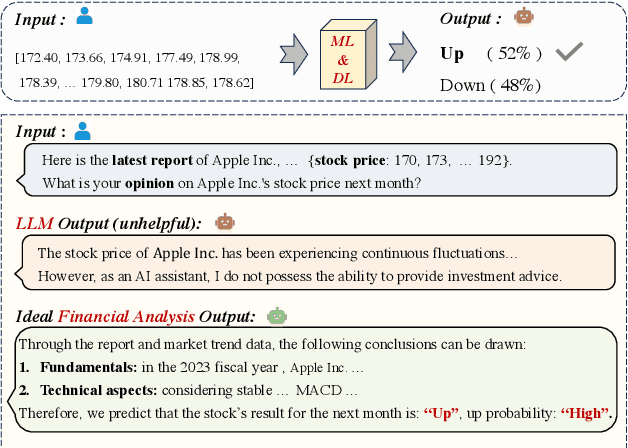
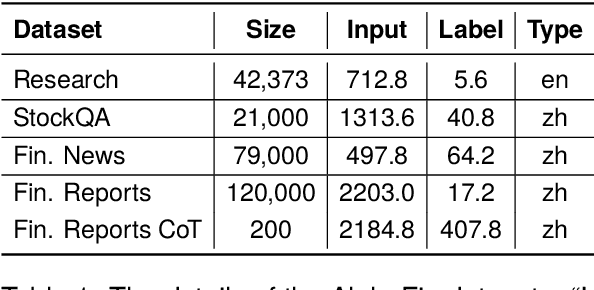
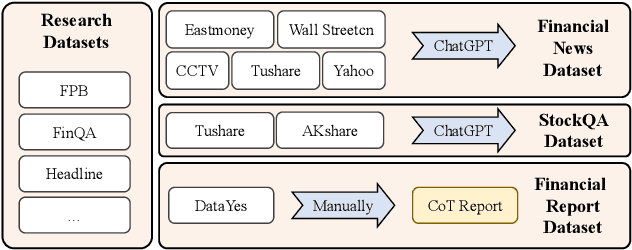
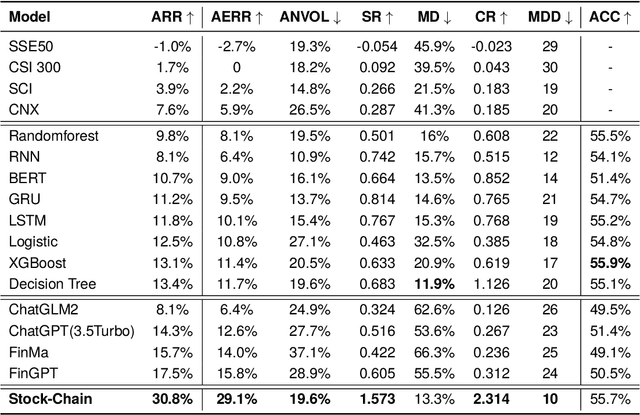
Abstract:The task of financial analysis primarily encompasses two key areas: stock trend prediction and the corresponding financial question answering. Currently, machine learning and deep learning algorithms (ML&DL) have been widely applied for stock trend predictions, leading to significant progress. However, these methods fail to provide reasons for predictions, lacking interpretability and reasoning processes. Also, they can not integrate textual information such as financial news or reports. Meanwhile, large language models (LLMs) have remarkable textual understanding and generation ability. But due to the scarcity of financial training datasets and limited integration with real-time knowledge, LLMs still suffer from hallucinations and are unable to keep up with the latest information. To tackle these challenges, we first release AlphaFin datasets, combining traditional research datasets, real-time financial data, and handwritten chain-of-thought (CoT) data. It has a positive impact on training LLMs for completing financial analysis. We then use AlphaFin datasets to benchmark a state-of-the-art method, called Stock-Chain, for effectively tackling the financial analysis task, which integrates retrieval-augmented generation (RAG) techniques. Extensive experiments are conducted to demonstrate the effectiveness of our framework on financial analysis.
CO3: Low-resource Contrastive Co-training for Generative Conversational Query Rewrite
Mar 18, 2024Abstract:Generative query rewrite generates reconstructed query rewrites using the conversation history while rely heavily on gold rewrite pairs that are expensive to obtain. Recently, few-shot learning is gaining increasing popularity for this task, whereas these methods are sensitive to the inherent noise due to limited data size. Besides, both attempts face performance degradation when there exists language style shift between training and testing cases. To this end, we study low-resource generative conversational query rewrite that is robust to both noise and language style shift. The core idea is to utilize massive unlabeled data to make further improvements via a contrastive co-training paradigm. Specifically, we co-train two dual models (namely Rewriter and Simplifier) such that each of them provides extra guidance through pseudo-labeling for enhancing the other in an iterative manner. We also leverage contrastive learning with data augmentation, which enables our model pay more attention on the truly valuable information than the noise. Extensive experiments demonstrate the superiority of our model under both few-shot and zero-shot scenarios. We also verify the better generalization ability of our model when encountering language style shift.
AACP: Aesthetics assessment of children's paintings based on self-supervised learning
Mar 12, 2024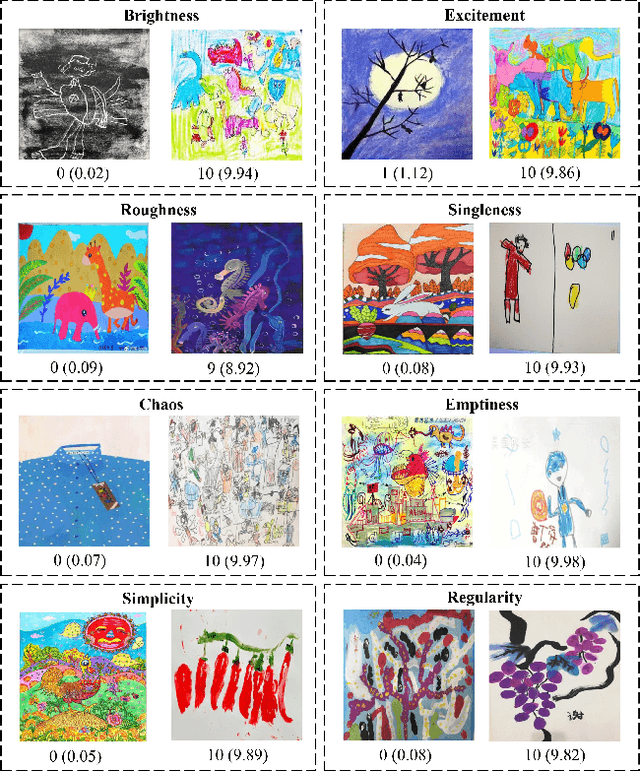
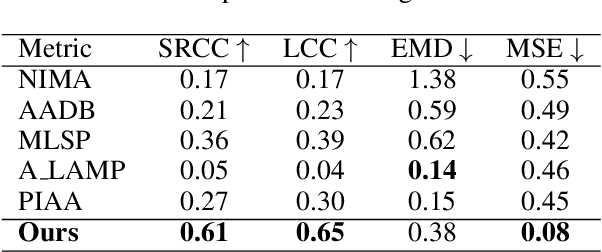

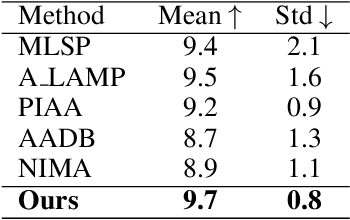
Abstract:The Aesthetics Assessment of Children's Paintings (AACP) is an important branch of the image aesthetics assessment (IAA), playing a significant role in children's education. This task presents unique challenges, such as limited available data and the requirement for evaluation metrics from multiple perspectives. However, previous approaches have relied on training large datasets and subsequently providing an aesthetics score to the image, which is not applicable to AACP. To solve this problem, we construct an aesthetics assessment dataset of children's paintings and a model based on self-supervised learning. 1) We build a novel dataset composed of two parts: the first part contains more than 20k unlabeled images of children's paintings; the second part contains 1.2k images of children's paintings, and each image contains eight attributes labeled by multiple design experts. 2) We design a pipeline that includes a feature extraction module, perception modules and a disentangled evaluation module. 3) We conduct both qualitative and quantitative experiments to compare our model's performance with five other methods using the AACP dataset. Our experiments reveal that our method can accurately capture aesthetic features and achieve state-of-the-art performance.
DreaMoving: A Human Video Generation Framework based on Diffusion Models
Dec 11, 2023



Abstract:In this paper, we present DreaMoving, a diffusion-based controllable video generation framework to produce high-quality customized human videos. Specifically, given target identity and posture sequences, DreaMoving can generate a video of the target identity moving or dancing anywhere driven by the posture sequences. To this end, we propose a Video ControlNet for motion-controlling and a Content Guider for identity preserving. The proposed model is easy to use and can be adapted to most stylized diffusion models to generate diverse results. The project page is available at https://dreamoving.github.io/dreamoving
DSVT: Dynamic Sparse Voxel Transformer with Rotated Sets
Jan 15, 2023Abstract:Designing an efficient yet deployment-friendly 3D backbone to handle sparse point clouds is a fundamental problem in 3D object detection. Compared with the customized sparse convolution, the attention mechanism in Transformers is more appropriate for flexibly modeling long-range relationships and is easier to be deployed in real-world applications. However, due to the sparse characteristics of point clouds, it is non-trivial to apply a standard transformer on sparse points. In this paper, we present Dynamic Sparse Voxel Transformer (DSVT), a single-stride window-based voxel Transformer backbone for outdoor 3D object detection. In order to efficiently process sparse points in parallel, we propose Dynamic Sparse Window Attention, which partitions a series of local regions in each window according to its sparsity and then computes the features of all regions in a fully parallel manner. To allow the cross-set connection, we design a rotated set partitioning strategy that alternates between two partitioning configurations in consecutive self-attention layers. To support effective downsampling and better encode geometric information, we also propose an attention-style 3D pooling module on sparse points, which is powerful and deployment-friendly without utilizing any customized CUDA operations. Our model achieves state-of-the-art performance on large-scale Waymo Open Dataset with remarkable gains. More importantly, DSVT can be easily deployed by TensorRT with real-time inference speed (27Hz). Code will be available at \url{https://github.com/Haiyang-W/DSVT}.
McQueen: a Benchmark for Multimodal Conversational Query Rewrite
Oct 23, 2022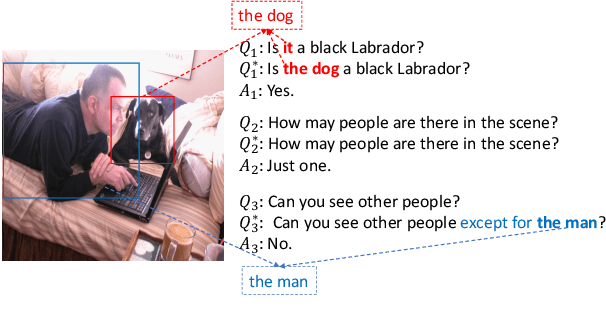

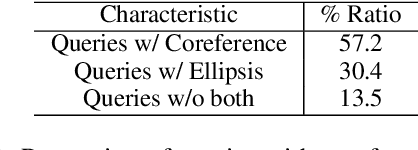
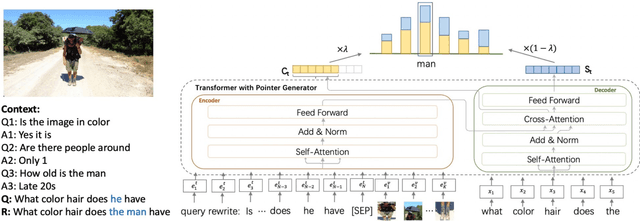
Abstract:The task of query rewrite aims to convert an in-context query to its fully-specified version where ellipsis and coreference are completed and referred-back according to the history context. Although much progress has been made, less efforts have been paid to real scenario conversations that involve drawing information from more than one modalities. In this paper, we propose the task of multimodal conversational query rewrite (McQR), which performs query rewrite under the multimodal visual conversation setting. We collect a large-scale dataset named McQueen based on manual annotation, which contains 15k visual conversations and over 80k queries where each one is associated with a fully-specified rewrite version. In addition, for entities appearing in the rewrite, we provide the corresponding image box annotation. We then use the McQueen dataset to benchmark a state-of-the-art method for effectively tackling the McQR task, which is based on a multimodal pre-trained model with pointer generator. Extensive experiments are performed to demonstrate the effectiveness of our model on this task\footnote{The dataset and code of this paper are both available in \url{https://github.com/yfyuan01/MQR}
Boosting 3D Object Detection via Object-Focused Image Fusion
Jul 21, 2022

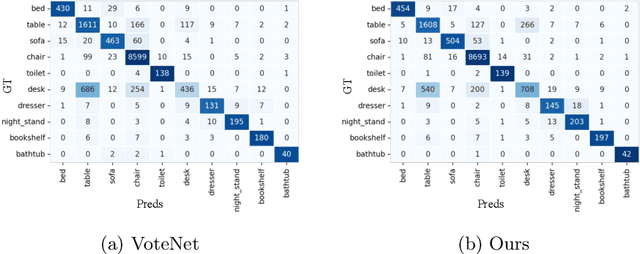
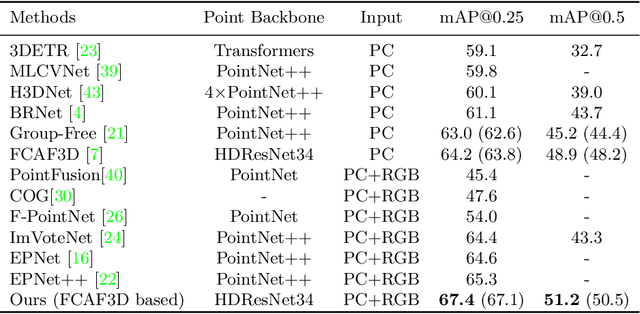
Abstract:3D object detection has achieved remarkable progress by taking point clouds as the only input. However, point clouds often suffer from incomplete geometric structures and the lack of semantic information, which makes detectors hard to accurately classify detected objects. In this work, we focus on how to effectively utilize object-level information from images to boost the performance of point-based 3D detector. We present DeMF, a simple yet effective method to fuse image information into point features. Given a set of point features and image feature maps, DeMF adaptively aggregates image features by taking the projected 2D location of the 3D point as reference. We evaluate our method on the challenging SUN RGB-D dataset, improving state-of-the-art results by a large margin (+2.1 mAP@0.25 and +2.3mAP@0.5). Code is available at https://github.com/haoy945/DeMF.
NER-BERT: A Pre-trained Model for Low-Resource Entity Tagging
Dec 01, 2021

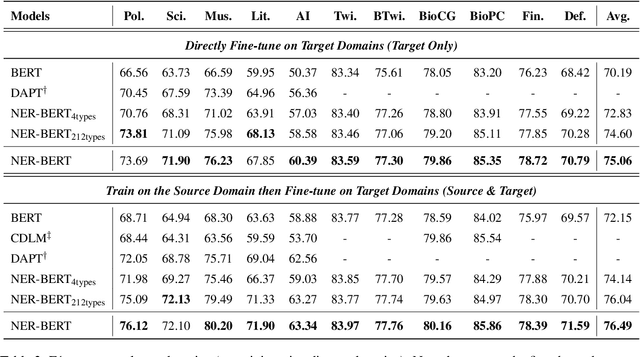
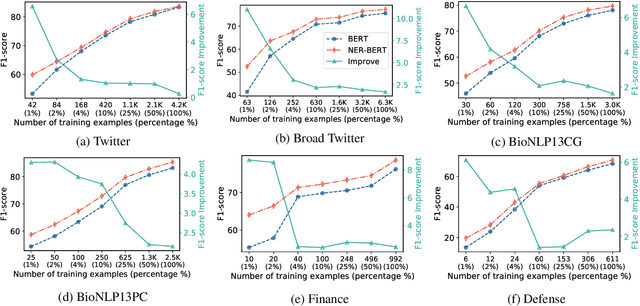
Abstract:Named entity recognition (NER) models generally perform poorly when large training datasets are unavailable for low-resource domains. Recently, pre-training a large-scale language model has become a promising direction for coping with the data scarcity issue. However, the underlying discrepancies between the language modeling and NER task could limit the models' performance, and pre-training for the NER task has rarely been studied since the collected NER datasets are generally small or large but with low quality. In this paper, we construct a massive NER corpus with a relatively high quality, and we pre-train a NER-BERT model based on the created dataset. Experimental results show that our pre-trained model can significantly outperform BERT as well as other strong baselines in low-resource scenarios across nine diverse domains. Moreover, a visualization of entity representations further indicates the effectiveness of NER-BERT for categorizing a variety of entities.
 Add to Chrome
Add to Chrome Add to Firefox
Add to Firefox Add to Edge
Add to Edge